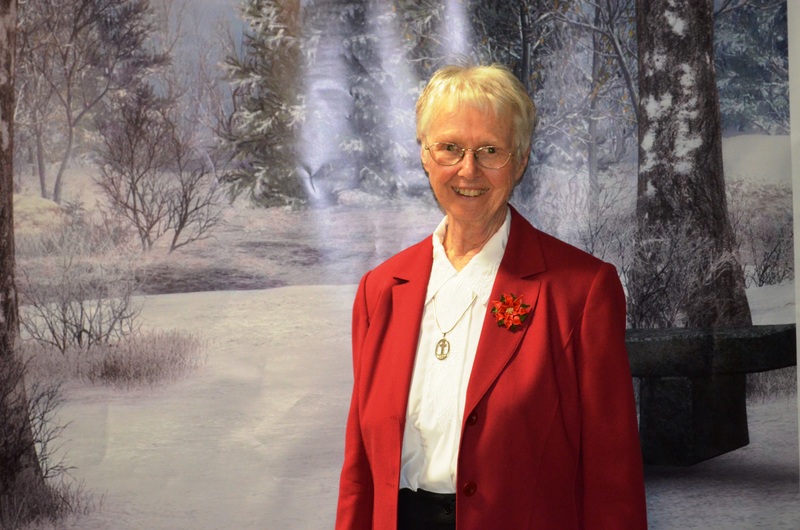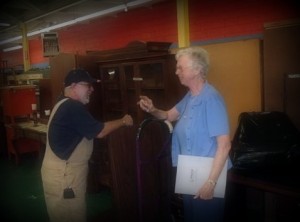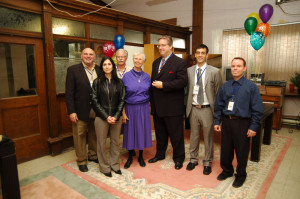Sister Anne Schenck would be the first to admit that there was no firm business plan when she first introduced Furniture Bank to Torontonians new and old back in 1996. Inspired by her past experiences helping new Canadians and buoyed by early support by a few key individuals and business owners, Sister Anne launched the organization almost two decades ago. In the years since, Furniture Bank has grown into Canada’s largest social enterprise and an archetype for similar services run across the globe.
Now serving as Furniture Bank’s founding director and “chief historian”, Sister Anne answered a few questions for volunteer Cam Gordon that help map out her Furniture Bank journey and ours.
What was your background before starting Furniture Bank?
Prior to Furniture Bank, I was in education. I was a teacher for 16 years and a principal in high schools for 17 years. I worked in Barrie, then Toronto, North York, Oshawa and Vancouver. Needless to say, when you’re a religious sister, you go anywhere.
There was a single family that truly helped inspire Furniture Bank as a concept and as an organization. Can you tell us about them?
Back in 1989, I was asked by the congregation to open a refugee centre in Scarborough. It was around that time that government reduced levels of funding for newcomers so they were literally moving into apartments with nothing. Interestingly, the family that inspired me into action wasn’t even a family that came through that centre. I received word through a social agency that there was a lady who spoke no English who was basically, desperate for help. When I entered the house, I saw four kids–all under the age of five–sitting around a little 12″ TV. I did a basic inventory of what she had in the kitchen: two plates, two forks, two tiny pots. I knew I couldn’t cook myself dinner with what she had, let alone cook dinner for these four children. It was that moment that I said to myself that this shouldn’t be happening in the city of Toronto. I was too busy running the refugee centre to do anything about it at that time but in that role, I was already collecting furniture and some household items. That’s where it began.
What were some of the earliest tasks to establish Furniture Bank and who were some of your earliest supporters?
When the refugee centre closed in 1994, I finally had some time to think about how I’d set up what became Furniture Bank. I had contacts at the Daily Bread Food Bank (@DailyBreadTO ) so they shared their bylaw information with me so I had a sense about what kind of regulations I’d need to consider to start something up. There was no business plan. I was just doing what I could do and I started talking about my dream. Around that time, I was at a university dinner and one of my classmates had become a judge. He offered to put me in touch with a lawyer (Hugh Morris) who offered me some pro bono services once things were underway. Similarly, I was put in contact with Peter Naylor from Tippet-Richardson movers, who I was told might be able to help me with some warehouse space. He did just that so when I pushed my foot a little further and we started talking about transportation, he offered us the use of a truck to help with pick-ups and drop-offs. It was really unbelievable–the help that people were offering when I shared my dream.
What level of support did you receive from politicians in the early going?
Peter Tabuns (@Peter_Tabuns ) was a city councillor in the 1990s and he was another early supporter. He just knocked on our door one day and listened to what it was we were trying to do. He helped broker a start-up grant of $3,000. There were also a lot of estate sale companies early on that were a great help. They were help coordinate with the owners of these homes and whatever they didn’t sell, they agreed to donate. It was a lot of coordination–learning when the estate sales were, where they were and what time to arrive. Keep in mind there was no actual office at this point. This was all done with my phone in my apartment and I was going out and picking up a lot of pieces in my car, when we couldn’t get help in terms of a van or a truck. Eventually, we had others help in those areas like Buckley Cartage, who agreed to provide us with free use of a moving van every Tuesday.
What were your first dealings with the late Jack Layton and how was he first introduced to the organization?
I actually first met Jack through Peter Tabuns. Both gentlemen had stopped by and I was telling them we wouldn’t be able to stay in the Tippet warehouse space much longer. Jack just handed me a card and basically told me that he knew a place that I could go. That was the space at 200 Madison, which of course gave us a proper dedicated space where we could arrange for pick-up and delivery of furniture and the opportunity to warehouse what we had.
What were some of the more memorable donations that you’ve seen come through Furniture Bank’s doors over the years?
There were many. As mentioned, the ease with which we’d receive things from the estate sales were invaluable. I remember going to one of these sales in 1999 in Mississauga with a car full of volunteers and a truck following. The lady who owned the house remarked how impressed she was by the amount of volunteers we had but also said she thought some of the volunteers looked like they needed help themselves. And she was right–many of them were former clients. A few months later, when that same lady was settled in her new home, we were sorting through the mail and received a letter from her. It was a cheque for $10,000. Just out of the blue. Five or six years later, the same family got back in touch and the daughter shared with me that we’d be receiving a cheque for $90,000. I couldn’t believe it–I assume I had just misheard and she was going to send $19,000 or even $9,000! Sure enough, it arrived and it was indeed $90,000. We were right on the edge when that donation came in so it played a huge, huge role in righting the organization and letting us move forward at that time.
Similarly, any client interactions stand out above others?
I remember one girl who came in who was eight-months pregnant and looking for a bed. I just couldn’t believe it and unfortunately, we were all out of beds at that time. The best we could do was take her phone number and give her a call as soon as a bed came in. But then sure enough, while we were having this conversation and she was getting ready to leave, a car pulled up with a mattress in the back. It was a former client who was actually returning a bed because he had turned things around in his life and purchased a new one. He wanted to return it to us now that he was back on his feet. It was a total “Hollywood ending” and one of the moments that really stuck with me. And believe me, there have been a lot.
Fast-forward to the present, what is your current role with the organization?
I’m still on the finance committee and the operations committee. But I like to say my role now is chief historian. A big part of that is keeping focus on what we’ve done and what we’re doing, and never lose sight of the gratitude we have for all our volunteers. We feel our volunteers are well paid in a way that’s not about money. They’re paid in having the chance to walk a family around the warehouse and be part of that reaction these families have when they’re given the freedom to choose and to receive. We try to keep that spirit alive through out the whole warehouse.
In closing, why do you think Torontonians were so quick to support Furniture Bank from the very beginning in 1996 and right through the present day?
Our support is all rooted in the fact that people want to see other people get helped. When people were downsizing or upgrading, there’d be surplus furniture and for many, this became a really natural opportunity to help. It’s not unlike what Shakespeare once wrote: “The quality of mercy is not strained”. It’s the same idea–just swap out mercy for helping. It speaks to the heart and it’s something that everybody everywhere can understand.









